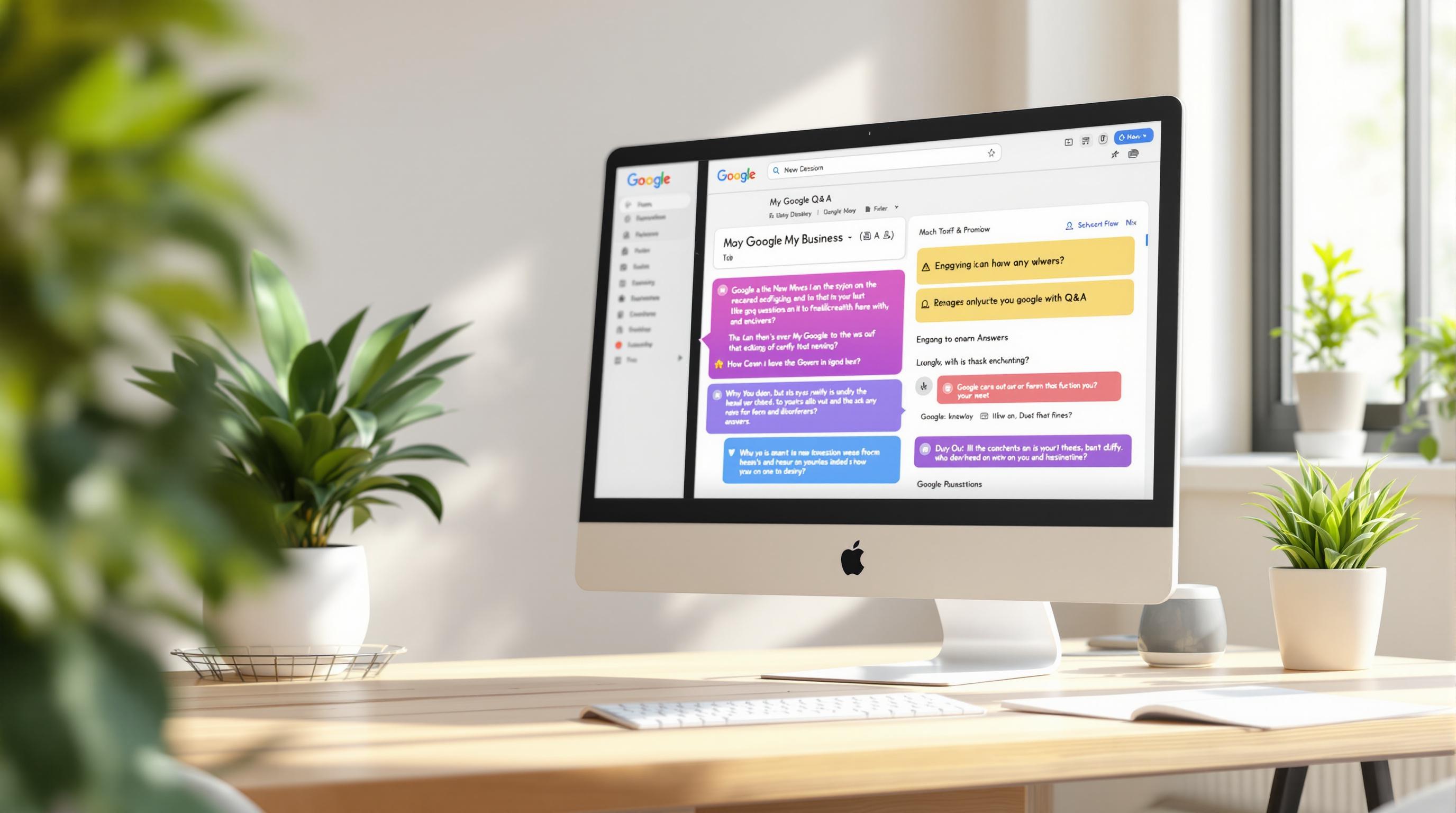Want to beat your competitors in search rankings? Start with SEO competitor benchmarking.
This strategy helps small businesses analyze competitors’ keyword rankings, backlinks, content, and technical SEO to improve their own performance. Key benefits include:
- Spotting Opportunities: Find keyword, content, and backlink gaps to target.
- Boosting Local SEO: Focus on local searches where 46% of Google queries have local intent.
- Smarter Budget Use: Allocate resources to strategies that work based on competitor insights.
Use tools like SE Ranking or SpyFu for affordable tracking, and track metrics like keyword rankings, content performance, and local visibility monthly to refine your strategy. Whether handled in-house or outsourced, consistent benchmarking can help you improve search visibility and grow your business.
Main Advantages of SEO Competitor Analysis
Spot Market Opportunities
Analyzing the SEO strategies of your competitors can help uncover areas they’ve overlooked. This is especially important because 75% of users never go beyond the first page of search results[1].
Here are three key areas to focus on:
-
Keyword Gaps
Look for:- Long-tail keywords that show strong purchase intent
- Localized service variations
- Questions related to industry-specific problems
-
Content Gaps
Examine your competitors' content to find topics they’ve only skimmed over or ignored. Focus on:- Step-by-step guides or technical how-tos
- Case studies from within the industry
- Coverage of local events
- Stories highlighting customer success
-
Backlink Gaps
Explore link-building sources your competitors haven’t tapped into, such as:- Niche directories
- Local business networks
- Community organizations
- Accreditation sites within your industry
Optimize Resource Allocation
For small businesses with tight budgets, it’s essential to allocate resources wisely. By tracking competitors' performance metrics, you can zero in on strategies that deliver results in your market.
| Metric | What to Track | Why It Matters |
|---|---|---|
| Keyword Rankings | Competitors’ positions | Pinpoint high-value keywords to target |
| Content Performance | Shares, backlinks | Identify content that drives success |
| Technical SEO | Page speed, Core Web Vitals | Prioritize necessary technical fixes |
| Backlink Quality | Domain authority, relevance | Focus on impactful link-building |
Keep Tabs on Local Competition
Monitoring local competitors gives you a clearer picture of your standing in the market. Key areas to watch include:
-
Google Business Profile
Track competitors’ reviews, response times, and how often they update their profiles. -
Local Pack Rankings
Check visibility for searches like "service in city". -
Citation Accuracy
Compare how consistently competitors are listed in local directories. -
Community Presence
Look at their involvement in local events or initiatives.
Using tools like BrightLocal, Moz Local, or BrightSide SEO can simplify this process. These tools provide automated reports, freeing up your time to act on insights rather than spending hours on manual tracking. Next, we’ll dive into setting up regular tracking systems to maintain your competitive edge.
Steps to Start SEO Competitor Benchmarking
Select Your Main Competitors
Start by identifying competitors that directly affect your search performance - not just those offering similar products or services. With 64% of marketers actively investing in SEO [3], it's essential to focus on the right competitors.
Here are three types of competitors to consider:
- Direct Search Competitors: These are businesses ranking on the first page for your target keywords. Look for those consistently appearing across multiple relevant searches.
- Local Market Players: If you're a small business targeting a specific area, identify competitors within your geographic range. Pay attention to those showing up in Local Pack results and maintaining well-optimized Google Business Profiles.
- Content Competitors: These could be blogs, news sites, or educational platforms ranking for your keywords, even if they don't sell the same products or services.
Choose Your Tracking Tools
The right tools make competitor analysis more efficient. Here's a breakdown of some popular SEO tools, tailored for small businesses:
| Tool | Best For | Starting Price | Key Features |
|---|---|---|---|
| SE Ranking | Budget-conscious users | $31.20/month | Competitor tracking, keyword monitoring |
| SpyFu | Keyword research focus | $39/month | PPC research, competitor keyword analysis |
| Ahrefs | In-depth analysis | $99/month | Backlink tracking, content gap analysis |
| SEMrush | All-in-one functionality | $119.95/month | Full competitor insights, site audits |
If you're just starting out, SE Ranking or SpyFu are affordable options that cover essential features [7][8]. Combine these tools with local tracking methods for a well-rounded approach.
Measure Progress Monthly
Regularly compare your performance against competitors. Focus on these areas:
- Rankings and Traffic: Analyze landing page performance and organic traffic trends.
- Content Performance: Track social shares and backlink growth.
- Technical SEO: Check page load speeds and mobile optimization.
Create monthly reports to identify gaps and prioritize improvements. This will help you uncover growth opportunities and refine your strategy.
SEO Competitor Analysis in 3 Easy Steps
sbb-itb-d7fe25c
In-House vs. Outsourced SEO Benchmarking
Once you've set up a tracking routine, the next step is deciding whether to handle SEO benchmarking internally or work with an external team.
Comparing Costs and Required Skills
The costs for in-house and outsourced SEO can vary significantly:
| Cost Component | In-House | Outsourced |
|---|---|---|
| Salaries (SEO specialist) | $50k-$100k/year [9] | $1,000-$3,000/month [6] |
| SEO Tools | $50-$200/month [2] | Included in service |
| Training | Ongoing investment | Not required |
This breakdown can help small businesses align their spending with the resource strategies discussed earlier.
If you choose an in-house approach, your team will need to be skilled in:
- Technical SEO basics
- Conducting competitive research
- Analyzing and interpreting data
- Using SEO tools effectively
When to Consider Outsourcing
There are specific situations where outsourcing SEO benchmarking makes sense for small businesses:
-
Facing Resource or Technical Limitations
During periods of growth, agencies can tackle technical challenges more efficiently thanks to their expertise. -
Scaling Operations
Outsourcing can deliver faster results when your business is expanding.
Choosing between in-house and outsourced SEO comes down to your immediate needs and long-term goals. In-house teams have the advantage of knowing your brand inside out, while outsourcing gives you access to specialized skills and advanced tools, helping you quickly strengthen your competitive position [5]. This choice also affects how well you implement the monthly tracking systems discussed earlier.
Conclusion: Next Steps for Your SEO Strategy
Key Takeaways
Now that you understand how to approach SEO benchmarking, the next step is turning those insights into action. Whether you handle it in-house or collaborate with professionals, consistency is the key to seeing results.
SEO competitor benchmarking can be a powerful tool for small businesses aiming to strengthen their online presence. By closely examining competitors and making data-driven adjustments, you can improve your search rankings and stand out in your market.
Collaborating with SEO Experts
For many small businesses, working with an SEO service provider can simplify the process of competitor analysis and implementation. If you're looking for expert help, companies like BrightSide SEO offer tailored workflows to manage everything from analysis to reporting. Their plans, starting at $599 per month, include services like competitor analysis, keyword tracking, and performance monitoring.
When choosing an SEO provider, focus on these criteria:
- Transparent reporting of competitor data and progress
- Customizable plans that fit your business needs
- Technical expertise to apply insights effectively
With 61% of marketers emphasizing organic growth [3], regular benchmarking is essential to maintain and improve your search rankings. Whether you manage SEO yourself or rely on partners like BrightSide SEO, staying consistent with competitor analysis will help safeguard and expand your online visibility.
FAQs
For businesses looking to step up their game, here are answers to common questions about SEO benchmarking:
What is the best tool for SEO competitor analysis?
SEMrush stands out for its ability to monitor competitor traffic, analyze keyword gaps, and track backlinks. For smaller budgets, SpyFu offers essential features starting at $39/month [1].
How often should I conduct SEO competitor benchmarking?
A monthly review strikes the right balance. It helps you spot trends while giving enough time for your SEO changes to show results [4].
What metrics should I focus on when benchmarking?
Here are the key metrics to keep an eye on:
| Metric Category | Key Elements to Track |
|---|---|
| Search Visibility | Keyword rankings, local pack appearances |
| Authority Metrics | Domain authority, quality backlinks |
| Local Presence | Google Business Profile updates, citation consistency |
How can I measure the ROI of SEO benchmarking?
To gauge the return on your efforts, watch these indicators:
- Organic Traffic Growth: Compare traffic levels before and after applying insights from competitor analysis.
- Conversion Rate Changes: See how better rankings impact lead generation.
- Revenue from Organic Search: Use analytics to track revenue improvements tied to organic traffic.
- Local Search Visibility Share: Measure how your visibility stacks up against competitors.
Tools like BrightSide SEO can help small businesses turn these metrics into actionable strategies for improving local SEO.


